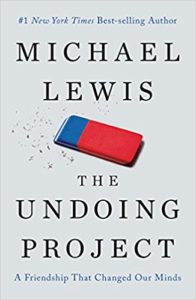
Michael Lewis’s book “The Undoing Project” is a story about the relationship between two people who studied how the mind works and, in particular, why we sometimes do unexpected things. I am big fan of “counter-intuitive” thinking and this book provided some clues to when we think well and when we trick ourselves into believing things that might not be in our best interest.
What is “Undoing”?
Undoing, as mentioned in the project, is the human nature to think of ways that some event might be “undone”. For example, if someone gets into an accident on the way to work it is common to think that if “they left just a few minutes earlier or later”, they would have avoided being at the location of the accident all together.
People often look for the smallest deviation that might create a new reality, and especially if they were wounded (either directly or indirectly) by the event it can make us feel better to think about how the past could be different. Making the past different” might be the simplest way to think of “Undoing” and the book discusses a number of parameters that we use.
For example, we look for small changes vs. large, maybe unlikely, changes. In the car accident example, we don’t usually say “If only they took the #2 bus to the A-train and then a cab from the station to work.” Simplicity is our friend when we are “Undoing”.
Quick side note… The last part of the book talks about how the relationship between the two psychologists, which had been highly productive for many years, begins to break down as they move in different directions. In a way, this is an “Undoing” too.
Here are some notes / observations from the book…
[starting on p.197] The ideas below will give you a sampling of the ideas presented in the book. Keep in mind that these ideas, while interesting by themselves, don’t really give you a taste for the stories that are an important part of the book.
- People predict by making up stories.
- People predict very little and explain everything.
- People live under uncertainty whether they like it or not.
- People believe they can tell the future if they work hard enough.
- People accept any explanation as long as it fits the facts.
[This seems to be related to the concept of Correlation vs. Causation. It is easy to think when something [consistently?] happens in sequence (i.e. correlated) that the first event causes the second when, in fact, there could be a completely different mechanism at work. – Coach Wheeler]
- The handwriting was on the wall, it was just the ink was invisible.
- People often work hard to obtain information they already have and avoid new knowledge.
- Man is a deterministic device thrown into a probabilistic universe. In this match, surprises are expected.
- Everything that has already happened must have been inevitable.
- We are exposed to a lifetime schedule in which we are most often rewarded for punishing others, and punished for rewarding.
- “Peak-end Rule” says that “Last impressions can be lasting impressions.” [p.236]
- [p.206-7] The “Hindsight Bias” is explained/discussed.
Bottom Line… Is The Undoing Project worth reading?
Short answer… Yes. Longer answer… If you like Michael Lewis’s style of writing and story-telling (e.g. The Blind Side, Moneyball or The Big Short), you will probably enjoy this book as well. In terms of things to learn about how the mind works, there are some good ideas (see notes above) but many of them are not common knowledge. I enjoyed the book and recommend “The Undoing Project” to anyone who has even a passing interest in psychology and how the mind works.
